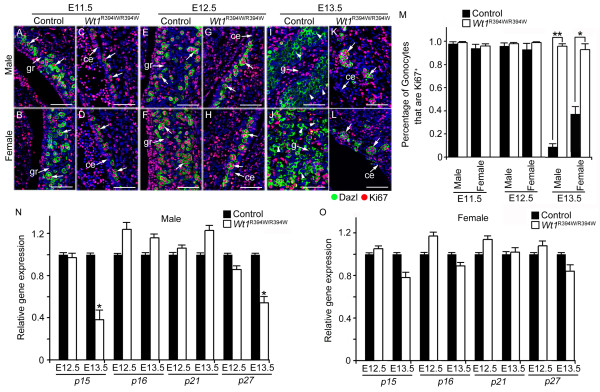Figure 7.

Abnormal germ cell proliferation was noted in GR-deficient embryos after sex determination. PGCs were labeled with Dazl (green), and proliferating cells were labeled with Ki67 (red). Most of the germ cells were Ki67-positive at E10.5 (A, B) and E11.5 (E, F), but the Ki67 signal was absent in most germ cells in control embryos after sex determination at E13.5 (I, J, white arrow-heads). In Wt1R394W/R394W embryos, germ cells were labeled with Ki67 at E10.5 (C, D) and E11.5 (G, H), similar to control embryos. However, the germ cells in Wt1R394W/R394W embryos remained Ki67-positive (K, L, white arrows) at E13.5. ce, coelomic epithelium; gr, genital ridge; g, gonad. Scale bars: 30 μm. Histogram summarizing selected percentage of gonocytes that were Ki67+ and note that the percentage of Ki67+ gonocytes were significantly increased in Wt1R394W/R394W embryos at E13.5, compared with control embryos at the same stage (M). The mRNA level of CDKI (p15INK4b, p16Ink4A, P21WAF1/Cip1 and p27Kip1) that inhibited the G1/S transition was estimated by real-time RT-PCR at E12.5 and E13.5 and normalized against PGC-specific marker Stella (N, O). * P <0.05, * * P <0.01. Each bar, mean ± SD of n = 3 experiments.
